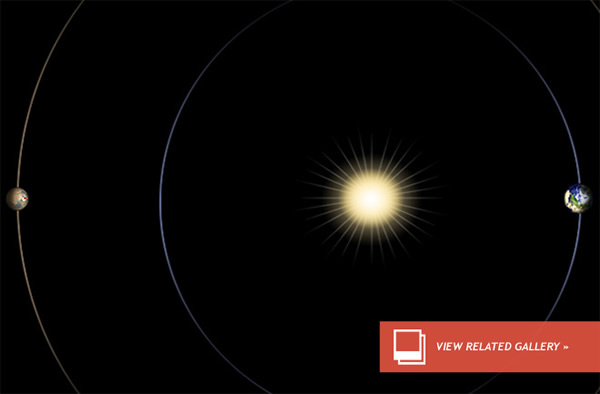Curiosity, Interrupted: Sun Makes Mars Go Dark
NASA has stopped sending commands to Mars rover Curiosity and will soon follow suit for rover Opportunity, Odyssey and the Mars Reconnaissance Orbiter (MRO). But don’t worry, government cutbacks haven’t severed interplanetary communications, you can blame the sun.
Once every 26 months the orbits of Earth and Mars align in such a way that our nearest star physically gets in the way of our line of sight. Known as a “Mars solar conjunction,” from our point of view, the red planet almost passes directly behind the solar disk. This means, inevitably, communications between the planets are severely disrupted.
Curiosity mission managers at NASA’s Jet Propulsion Laboratory (JPL) in Pasadena, Calif., suspended communications with the one-ton robot yesterday (April 4) so to avoid any corruption of data. They won’t recommence transmissions until May 1.
Curiosity, Interrupted: Sun Makes Mars Go Dark
The sun’s lower atmosphere (the corona) is buzzing with highly charged particles, causing interference with radio communications that pass through it. Also, each conjunction is different, depending on orbital inclination and solar activity. The sun is currently undergoing “solar maximum” — peak activity for its approximate 11-year cycle. This conjunction will see Mars close in on the solar limb by only 0.4 degree on April 17 — a maximum period for interference.
Although receiving data from the rover isn’t too much of a problem (blocks of missing data can be requested again later), sending commands, only for the data to become corrupted on the way to Mars, could be a serious issue for the health of the mission.
Commands to the NASA orbiters will also be suspended from April 9 to 26. The MRO has been switched to a “record only” mode whereas the veteran Odyssey will continue to transmit throughout the conjunction — although NASA is expecting the inevitable data drop-outs particularly around April 17. Operations of the European Mars Express satellite, which has been orbiting Mars since 2003, will also be affected.
“For the entire conjunction period, we’ll just be storing data on board (the Mars Reconnaissance Orbiter),” said JPL’s Reid Thomas, MRO Deputy Mission Manager. The orbiter is expected to accumulate 40 gigabits of science data from its own instruments and 12 gigabits of data from Curiosity, which will all be downloaded to Earth around May 1.
“This is our sixth conjunction for Odyssey,” said Chris Potts, Odyssey mission manager at JPL. “We have plenty of useful experience dealing with them, though each conjunction is a little different.” Odyssey has been orbiting Mars since 2001.
“The biggest difference for this 2013 conjunction is having Curiosity on Mars,” added Potts.
Although NASA won’t be transmitting, Curiosity will be sending regular “beeps” to Earth to reassure us that it’s OK. “We will maintain visibility of rover status two ways,” said Torsten Zorn, conjunction planning leader for Curiosity’s JPL engineering operations team. “First, Curiosity will be sending daily beeps directly to Earth. Our second line of visibility is in the Odyssey relays.”
Curiosity landed inside Gale Crater on Aug. 5, 2012, and has already made groundbreaking (literally) progress in the hunt of evidence for past (and present) habitability of the red planet. This communications blackout is the first time Curiosity will be alone.
Apr 5, 2013 02:36 PM ET by Ian O'Neill












